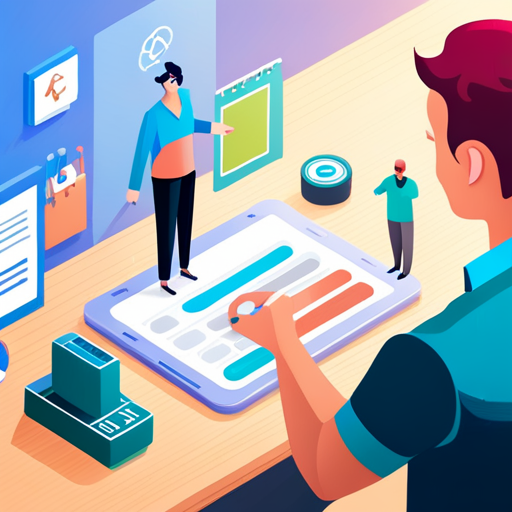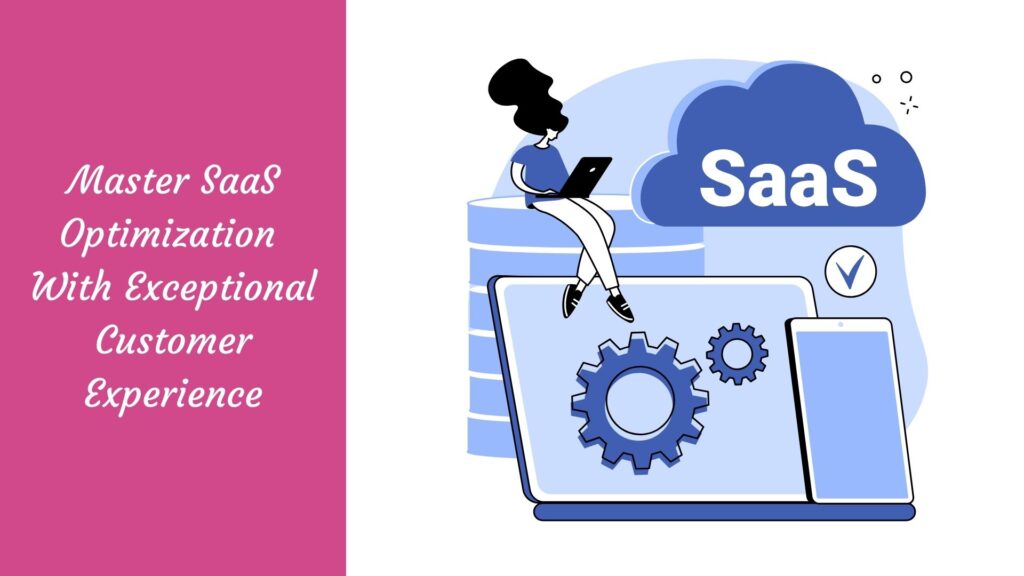
The world of SaaS is rapidly growing as more businesses are turning to SaaS solutions to streamline their processes and enhance their productivity. As more players enter the SaaS space, the competition is stiffening, and companies have to stay on top of their games not to be left behind.
The key to success in this industry often lies in how effectively a company can optimize its customer experience. In this blog post, we’ll look at the importance of customer experience in SaaS optimization and how you can enhance it to stay ahead of the competition.
What are the benefits of a good customer experience?
- Customer Loyalty: A positive customer experience promotes loyalty, making customers more likely to continue using your service and less likely to switch to a competitor.
- Word of Mouth Marketing: Satisfied customers are more likely to recommend your services to others that increases your customer base without any extra advertising costs.
- Increased Customer Lifetime Value: The more positive experiences a customer has, the more likely they are to make repeat purchases, increasing their lifetime value to your business.
- Improved Reputation: A company known for delivering exemplary customer experiences can enjoy a more substantial, more positive reputation.
- Reduced Customer Churn: A good customer experience can result in lower customer churn rates, increasing customer retention.
- Competitive Advantage: Providing superior customer experience can set you apart from competitors and can be a significant differentiator in the market.
- Positive Online Reviews: Satisfied customers often leave positive reviews online which can attract new customers.
- Increased Customer Trust: When customers have consistently good experiences with a company, their trust in that company increases.
- Higher Revenue: Good customer experience is linked to higher revenue as satisfied customers are more likely to make additional purchases and buy more often.
- Customer Satisfaction: Providing a good customer experience leads to increased customer satisfaction which can lead to all the above benefits.

How do We Measure Customer Experience?
To measure customer experience effectively, you can follow these steps:

- Collect Customer Feedback: Use tools like surveys, net promoter score (NPS), and customer reviews to gather feedback. This feedback can provide insights into where your service is excelling and where it needs improvement.
- Analyze Customer Interactions: Analyze interactions across all customer touchpoints, including email, social media, live chat, etc. Look for patterns and trends in these interactions to understand customer sentiments and preferences.
- Track Customer Retention and Churn Rates: High retention rates and low churn rates indicate positive customer experience. However, if the opposite is true, it may signal dissatisfaction with your service.
- Monitor Customer Support Metrics: Important metrics include response time, first contact resolution, and customer satisfaction scores post-support.
- Conduct Usability Tests: Usability tests can reveal issues that hinder the customer’s ability to use your service effectively.
Consistently measuring and analyzing customer experience is an ongoing process that is key to continual service improvement and optimization.
Here is How to Master SaaS Optimization
SaaS optimization can help you enhance the customer experience in the following ways:

Understanding Customer Experience for SaaS Optimization
In SaaS, customer experience refers to how users feel about the product, from their initial interaction with it to their digestion and assimilation of the product information and how well it intersects with their demands. Providing an exceptional customer experience enhances customer retention and reduces churn rates.

By understanding the customers’ demands and how the product delivers on those demands, software development teams can significantly optimize their goal for a better user experience. In essence, optimization is an ongoing process that requires continuous feedback collection and the implementation of changes to meet customer needs effectively.
Enhancing Customer Experience through Personalization
One of the key ways to optimize customer experience in SaaS is through personalization. By tailoring the product to meet specific user needs, companies can increase overall satisfaction and loyalty. It could be achieved by offering personalized onboarding experiences, customized features based on user preferences, or even targeted marketing campaigns.

Companies can use data analytics to gain insights into customer behavior & preferences, leading to personalized experiences.
Effective Communication Channels
In addition to personalization and feedback collection, having effective communication channels is vital for optimizing customer experience in SaaS. Customers should have easy access to support and be able to reach out with any queries or concerns.

Companies can also use communication channels to keep customers informed about updates, new features, and any other relevant information. It helps build trust with customers and keeps them engaged with the product.
Minimizing User Frustrations
The most common issues with SaaS products lie in the usability, bug, and integration issues that curtail user experience. According to a study, applications that cause user frustration significantly impact retention rates, which often leads to the loss of revenue. It is essential to understand the users’ pain points and address them before releasing the product to the market.

By putting users at the forefront through research and development, UX designers and product managers can optimize the product to offer exceptional user experiences. Additionally, offering excellent customer support can help reduce user frustrations and improve overall satisfaction.
Enhancing User Training and Onboarding
User training and onboarding should always be user-centric. New users should get relevant information in the shortest possible time to maximize user engagement.

The product experience should be agile and straightforward, with a learning experience designed to eliminate confusion and improve User experience.
Subsequently, users must have their issues promptly addressed to ensure they can optimize the experience of the product.
Monitoring User Feedback and Reviews
When dealing with SaaS products, reviewing customer feedback and reviews is crucial to optimizing their product experience. Customer feedback often contains insights into the most pressing user issues and how to fix them.

SaaS developers should monitor feedback and review channels to gain an understanding of the product and user perception. Analyzing user feedback can provide real-time insights into the most critical aspects of a product, enabling the team to direct their efforts toward optimal performance.
Experimenting with New Features
SaaS optimization significantly depends on experimenting with the latest features. Leveraging new features brings a positive difference to users’ overall experience. A/B testing and analytics are essential tools in the assessment and optimization of the latest features integrated into a SaaS product.

By taking calculated risks, SaaS development teams can optimize the product experience and differentiate their products from competitors in the market.
FAQs
How do product teams ensure a positive customer experience with SaaS optimization?
Product teams ensure a positive customer experience with SaaS optimization by constantly monitoring user behavior, feedback, and needs. Analytics tools are utilized to gain insights into user behavior, while feedback platforms are used for understanding user needs and pain points. The product is then continually updated and improved based on these insights.
Furthermore, product teams collaborate closely with customer support and success teams to ensure customer issues are promptly resolved, thereby enhancing the user experience. Additionally, they experiment with new features, conduct A/B tests, and make iterative improvements to optimize the product and enhance customer satisfaction.
What strategies have been effective for SaaS product development teams to drive success and user satisfaction?
Practical strategies that SaaS product development teams employ to drive success and user satisfaction include:
- User-Centric Design: Developing the product with a focus on the user’s needs and experiences. It involves understanding the user’s journey and designing features that enhance their interaction and overall experience with the product.
- Continuous Improvement: Regularly updating and refining the product based on user feedback and data-driven insights. It ensures the product remains relevant and meets the evolving needs of users.
- Innovative Features: Regularly introducing new and innovative features that provide value to the users and differentiate the product in the market.
- Scalability: Designing the product to be scalable. It allows the product to handle increased user load, making it more reliable and ensuring a consistent user experience.
- Security: Prioritizing the security of the product to protect user data and build trust among users.
- Customer Support: Providing excellent customer support that resolves issues promptly, enhances the user experience, and builds long-term relationships with customers.
What are the biggest challenges that developers encounter when optimizing their SaaS-based products?
Developers encounter several challenges when optimizing their SaaS-based products. One of the primary obstacles is Ensuring Data Security and Privacy.
As SaaS applications store user data on cloud servers, ensuring data security and handling privacy concerns becomes paramount.
Another challenge is Scalability. As the user base grows, SaaS applications need to scale efficiently while maintaining performance and user experience.
Integrations also pose a significant challenge. SaaS applications often need to integrate with other platforms and services, which can be complex, time-consuming, and may lead to compatibility issues.
Updating and Deployment can be tricky as developers need to ensure that updates are rolled out smoothly without causing downtime or disruptions to the user.
Lastly, Customer Support and Service is always a challenge. With users across different time zones, providing round-the-clock support and resolving issues rapidly is crucial to retaining user satisfaction and trust.
What tips can IT-minded professionals offer to help users of SaaS maximize the benefits of the software?
IT professionals offer several tips for maximizing the benefits of SaaS software:
- Understand Your Needs: Before you choose any SaaS product, determine your specific needs and ensure the software meets those requirements. This understanding will help in optimizing the implementation and usage of the software.
- Take Advantage of Integrations: Many SaaS solutions offer integrations with other software. Leverage these integrations to boost productivity and efficiency.
- Utilize Training Resources: Most SaaS providers offer comprehensive training resources, including tutorials and webinars. Utilize these resources to understand the software thoroughly and use it effectively.
- Stay Updated: SaaS providers often release new features and updates. Stay informed of these updates to make the most of the software’s capabilities.
- Leverage Customer Support: In case of any difficulties or issues, don’t hesitate to reach out to the customer support team. They are there to assist you and can guide you in better utilizing the software.
- Prioritize Security: Ensure you follow best practices for data security. It includes regular password updates, limiting access to sensitive data, and staying vigilant about potential threats.
- Request Custom Features: If your organization has unique needs not addressed by the SaaS product, request custom features from the provider. Many SaaS providers are open to developing such features to meet their clients’ specific needs.
From the viewpoint of customers, what constitutes an exemplary customer experience when using SaaS products?
Several key factors can define an exemplary customer experience in the context of SaaS products:
- Ease of Use: The software should be user-friendly and intuitive, enabling customers to familiarize themselves with the interface and features quickly.
- Reliability: The software must function correctly and consistently, with minimal downtime or glitches.
- Robust Features: The software should offer a comprehensive set of features that effectively meet the needs of the user.
- Efficient Customer Support: Prompt, helpful, and friendly customer support is crucial. It should also include comprehensive resources for self-help.
- Affordability: The product should offer good value for money. It doesn’t necessarily mean being the cheapest, but it should justify its cost with robust features and excellent performance.
- Scalability: The SaaS product should be able to scale with the growth of the customer’s business, accommodating an increase in users and data volume.
- Security: The SaaS provider should ensure robust security to protect users’ data and maintain trust.
- Regular Updates and Improvements: The software should be regularly updated with new features, improvements, and bug fixes based on customer feedback.
It’s also important to remember that exemplary customer experiences can vary based on the specific needs and preferences of different users.
Conclusion
Optimizing customer experience holds the key to a successful SaaS product. By implementing some of the above approaches, SaaS teams can significantly enhance the performance of a product while ensuring that clients remain engaged longer.
It is essential to remember that the development process is a continuous cycle, and optimization efforts should be ongoing to keep pace with the fast-changing technological landscape.

10+ years experience in Marketing and Operations
